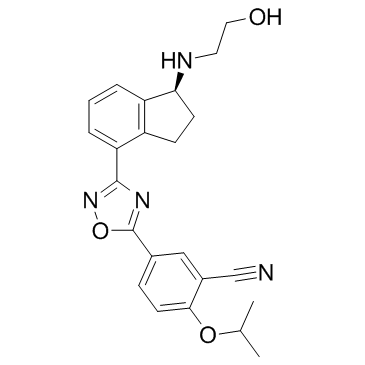1306760-87-1
| Name | Ozanimod |
|---|---|
| Synonyms |
Benzonitrile, 5-[3-[(1S)-2,3-dihydro-1-[(2-hydroxyethyl)amino]-1H-inden-4-yl]-1,2,4-oxadiazol-5-yl]-2-(1-methylethoxy)-
(S)-5-(3-(1-((2-hydroxyethyl)amino)-2,3-dihydro-1H-inden-4-yl)-1,2,4-oxadiazol-5-yl)-2-isopropoxybenzonitrile 5-(3-{(1S)-1-[(2-Hydroxyethyl)amino]-2,3-dihydro-1H-inden-4-yl}-1,2,4-oxadiazol-5-yl)-2-isopropoxybenzonitrile RPC1063 Ozanimod UNII-Z80293URPV RPC-1063 |
| Description | Ozanimod is a potent and selective S1P1 and S1P5 receptor agonist with EC50s of 410±160 pM and 11±4.3 nM in [35S]-GTPγS binding, respectively. |
|---|---|
| Related Catalog | |
| Target |
EC50: 410±160 pM (S1P1 receptor), 11±4.3 nM (S1P5 receptor)[1] |
| In Vitro | Ozanimod (RPC1063) is a potent sphingosine-1-phosphate receptor-1 (S1P1) and receptor-5 (S1P5) agonist. The EC50 values are subnanomolar for S1P1 receptors whether measuring inhibition of cAMP generation (160±60 pM) or [35S]-GTPγS binding (410±160 pM). The EC50 value for S1P5 receptor whether measuring inhibition [35S]-GTPγS binding (11±4.3 nM). Ozanimod demonstrates agonist activity at the S1P5 receptor [11±4.3 nM and 83% Emax (percentage of maximum stimulation)]. To determine whether Ozanimod induces sustained S1P1 receptor internalization, S1P1 receptor-HEK293T cells are incubated with different doses of Ozanimod in the presence of 10 μM cycloheximide to prevent translation of new S1P1 receptor protein. Cells are analysed after 1 h treatment, or, after the 1 h treatment washed thoroughly to remove Ozanimod and incubated with 1 μM Cycloheximide for a further 24 h. After a 1 h treatment Ozanimod induces significant loss of S1P1 receptor cell surface expression, similar in magnitude and potency to that seen with FTY720-P-treated cells. Following 1 h of treatment and a 24 h washout period, Ozanimod demonstrates a dose-dependent effect on S1P1 receptor re-expression on the cell surface, with near complete and sustained loss of cell surface receptor expression at concentrations above 10 nM[1]. |
| In Vivo | Ozanimod (RPC1063) is specific for S1P1 and S1P5 receptors, induces S1P1 receptor internalization and induces a reversible reduction in circulating B and CCR7+ T lymphocytes in vivo. Ozanimod shows high oral bioavailability and volume of distribution, and a circulatory half-life that supports once daily dosing. Oral Ozanimod reduces inflammation and disease parameters in all three autoimmune disease models[1]. |
| Cell Assay | Representative histograms of transfected HEK293T cells expressing S1P1 receptors incubated with vehicle control or 1 μM RPC1063. HEK293T cells are incubated with increasing doses of Ozanimod (0.01 nM, 0.1 nM, 1 nM, 10 nM, 100 nM, 1 μM and 10 μM) for 1 h, or for 1 h followed by extensive washing to remove compound, then a 24 h recovery period and cell surface receptor expression is monitored[1]. |
| Animal Admin | Mice[1] Female C57BL/6 mice (60 total, 10 weeks of age) are immunized with Myelin Oligodendrocyte Glycoproteins (MOG) 35-55 peptide with complete Freund's adjuvant on day 0, and pertussis toxin is administered 2 h and 24 h later. At the first instance of clinical symptoms of EAE (limp tail), mice are randomized into treatment groups (n=10 per group) and administered the test compound, p.o., once daily for 14 days. Mice that develop disease earlier than 9 days post-immunization are not enrolled, as these often develop fulminant disease that does not respond to therapy. Test compounds are 0.2 and 0.6 mg/kg Ozanimod, 3 mg/kg FTY720 or vehicle (5% DMSO, 5% Tween-20, 90% 0.1 N HCl). Animals are monitored daily for body weight and clinical symptoms and scored. At the end of the study, mice are anaesthetized via inhalation of isoflurane bubbled with oxygen at 10-20 kPa, blood drawn via cardiac puncture to exsanguination and analysed by a veterinary haemoanalyser. |
| References |
| Density | 1.3±0.1 g/cm3 |
|---|---|
| Boiling Point | 648.3±65.0 °C at 760 mmHg |
| Molecular Formula | C23H24N4O3 |
| Molecular Weight | 404.462 |
| Flash Point | 345.9±34.3 °C |
| Exact Mass | 404.184845 |
| PSA | 104.20000 |
| LogP | 4.25 |
| Vapour Pressure | 0.0±2.0 mmHg at 25°C |
| Index of Refraction | 1.635 |
| Storage condition | -20℃ |
